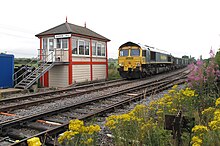
Back Stellwerk ALS Sikringsanlæg Danish Stellwerk German Enclavamiento Spanish کنترل و علائم Persian Asetinlaite Finnish Poste d'aiguillage French Vasúti biztosítóberendezés Hungarian Kendali persinyalan ID Posto di movimento Italian

On a rail transport system, signalling control is the process by which control is exercised over train movements by way of railway signals and block systems to ensure that trains operate safely, over the correct route and to the proper timetable. Signalling control was originally exercised via a decentralised network of control points that were known by a variety of names including signal box (International and British), interlocking tower (North America) and signal cabin (some railways e.g., GCR). Currently these decentralised systems are being consolidated into wide scale signalling centres or dispatch offices. Whatever the form, signalling control provides an interface between the human signal operator and the lineside signalling equipment. The technical apparatus used to control switches (points), signals and block systems is called interlocking.